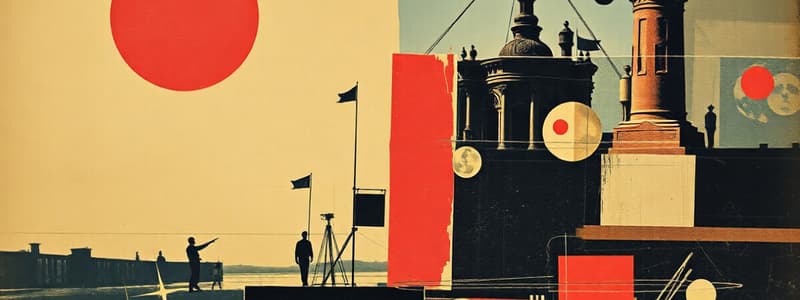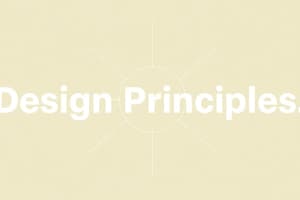Podcast
Questions and Answers
What principle of design involves the visual weight of elements on a page?
What principle of design involves the visual weight of elements on a page?
- Rhythm
- Balance (correct)
- Unity
- Contrast
Which of the following colors is classified as a secondary color?
Which of the following colors is classified as a secondary color?
- Blue-Green
- Yellow
- Red
- Orange (correct)
What does the principle of emphasis in graphic design aim to achieve?
What does the principle of emphasis in graphic design aim to achieve?
- To draw attention to specific elements (correct)
- To maintain color harmony
- To create visual hierarchies
- To ensure symmetry in design
Which design principle combines multiple elements to create visual interest?
Which design principle combines multiple elements to create visual interest?
What is saturation in color theory?
What is saturation in color theory?
In design, what does the principle of rhythm refer to?
In design, what does the principle of rhythm refer to?
What are primary colors according to color theory?
What are primary colors according to color theory?
Which of the following terms best describes the cohesion of all elements within a design?
Which of the following terms best describes the cohesion of all elements within a design?
What is created by adding black to a hue?
What is created by adding black to a hue?
Which color combination represents complementary color harmony?
Which color combination represents complementary color harmony?
Which term refers to a color scheme that uses one base color and the two colors adjacent to its complementary color?
Which term refers to a color scheme that uses one base color and the two colors adjacent to its complementary color?
What is the positive association of the color blue in color psychology?
What is the positive association of the color blue in color psychology?
Which type of typeface was developed during the 14th Century by Johannes Gutenberg?
Which type of typeface was developed during the 14th Century by Johannes Gutenberg?
What does the term 'ligature' refer to in typography?
What does the term 'ligature' refer to in typography?
Which of the following is described as having small feet at the end of a stroke in typography?
Which of the following is described as having small feet at the end of a stroke in typography?
What component of a lowercase letter extends below the baseline?
What component of a lowercase letter extends below the baseline?
Which type of stroke is referred to as the main vertical line stroke of a letter?
Which type of stroke is referred to as the main vertical line stroke of a letter?
During which period did designers start creating geometric and humanistic typefaces?
During which period did designers start creating geometric and humanistic typefaces?
Flashcards
Shade
Shade
A hue made darker by adding black to a color, resulting in a richer tone.
Tint
Tint
A hue made lighter by adding white to a color, resulting in a less intense tone.
Tone
Tone
A hue that is created by adding black, white, or gray to a color.
Complementary Colors
Complementary Colors
Signup and view all the flashcards
Color Harmony
Color Harmony
Signup and view all the flashcards
Typography
Typography
Signup and view all the flashcards
Serif
Serif
Signup and view all the flashcards
Ascender
Ascender
Signup and view all the flashcards
Descender
Descender
Signup and view all the flashcards
Ligature
Ligature
Signup and view all the flashcards
Balance (Graphic Design)
Balance (Graphic Design)
Signup and view all the flashcards
Unity (Graphic Design)
Unity (Graphic Design)
Signup and view all the flashcards
Contrast (Graphic Design)
Contrast (Graphic Design)
Signup and view all the flashcards
Repetition (Graphic Design)
Repetition (Graphic Design)
Signup and view all the flashcards
Primary Colors
Primary Colors
Signup and view all the flashcards
Secondary Colors
Secondary Colors
Signup and view all the flashcards
Tertiary Colors
Tertiary Colors
Signup and view all the flashcards
Study Notes
Graphic Design History & Principles
- Graphic design emerged from the development of written language in Sumeria (3000 BCE) leading to typographic advancements (1050-1500 AD).
- Movable printing presses appeared around 1040 AD.
- The 1950s marked the beginning of the digital era.
- Graphic design is a communication tool employing design principles.
Design Principles
- Balance: Visual weight distribution across a design.
- Symmetrical: identical elements on both sides.
- Asymmetrical: unequal but balanced layout
- Unity: Harmonious relationship between elements.
- Contrast: Differences between design elements to establish hierarchy. Use colors, sizes, textures etc.
- Repetition: Repeating elements creates visual consistency.
- Pattern: Repeating multiple elements generates a pattern.
- Rhythm: Repeated elements with variation to create a visual tempo
- Movement: Guides the viewer's eye via lines or direction.
- Emphasis: Directs viewer attention to crucial design elements.
- Proportion: Creates unity through the harmonious relationship of design elements.
- Harmony: Sense of cohesiveness among design components.
- Variety: Fosters interest and engagement with diverse design elements
Color Theory
- Color Wheel: Visual tool for understanding color relationships.
- Sir Isaac Newton created the traditional color wheel in 1666.
- Primary Colors: Red, Blue, Yellow.
- Secondary Colors: Green, Orange, Purple.
- Tertiary Colors: Combinations of primary and secondary colors.
- Color Qualities:
- Hue: Color itself (e.g., red).
- Saturation: Purity or intensity (e.g. vibrant vs. dull).
- Value: Lightness or darkness (e.g., light blue vs. dark blue).
- Shade: Adding black to a color.
- Tint: Adding white to a color.
- Tone: Adding gray to a color.
- Color Harmony: Creates visually pleasing color combinations.
- Complementary(opposite colors), Split complementary, Analogous, Monochromatic, Triadic, and Tetradic schemes.
- Color Psychology:
- Colors evoke different emotions and associations. (Examples: red evokes power, blue evokes trust, green evokes health)
Typography
- Typography: Strategic arrangement of text for clarity and impact.
- Early Typography: Inscriptions on monuments, followed by the development of typefaces and printing presses.
- Johannes Gutenberg: Invented the movable type printing press.
- Industrial Revolution: Printing presses facilitated advertising and newspaper designs, including variations in typeface.
- Slab Serif Typefaces: Bold and punchy typeface revival.
- Roman Typefaces: Became more common due to readability over black letter.
- Modernist Typefaces: Geometric and humanistic typefaces (Futura, Gill Sans, Helvetica) emerged.
Type Anatomy
- Serif: Small strokes at the ends of letters (e.g., Times New Roman).
- Ascender: Portion of lowercase letters above the x-height (e.g., 'd').
- Descender: Portion of lowercase letters below the baseline (e.g., 'g').
- Axis: Direction of a letter's stroke.
- Bowl: Curved portion of a letter.
- Stem: Main vertical stroke of a letter.
- Spine: Curvy stroke, often vertical or horizontal (e.g., 'S' or 's').
- Ligature: Special character combinations (e.g., 'f' and 'i').
- Lowercase: Small letters.
- Uppercase: Capital letters.
- Eye: Closed part of a letter (e.g., 'e', 'o').
Studying That Suits You
Use AI to generate personalized quizzes and flashcards to suit your learning preferences.




